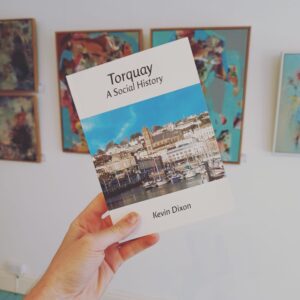Torquay’s burial grounds change as the town changes.
As Torquay developed during the nineteenth century, the town’s traditional burial grounds of St Saviour’s in Torre and at Upton became overused. Alongside this obvious overcrowding and competition for space, old medieval churchyards were seen as a being source of ‘miasma’, a stench that was believed could poison residents.
Torquay’s traditional burial grounds were at St Saviour’s in Torre and Mary Mags
Even though additions were made to Torre’s churchyard in 1836 and 1842, this was still insufficient for a town that had a population of only 838 at the beginning of the nineteenth century but 11,474 in 1851. We were on the way to being the richest town in England and so deserved a modern solution to an old problem.
In February 1850 residents petitioned for a prohibition on further burials at Upton. Accordingly, in 1852 sixteen acres of agricultural land, adjacent to brickworks and potteries, was purchased on high ground on the outskirts of town. This was near a place named after the Old English word for ‘hidden’: Hele.
This would be a High Victorian Garden Cemetery and was established by a commercial organisation, The Torquay Extra Mural Cemetery Company. Known as Torquay Cemetery, or as Barton Road Cemetery, it became the town’s primary last resting place for both locals and visitors when the churchyard at Torre closed to burials in 1895.
Significantly, this was a private company and not the ‘communally owned’ Church, an endeavour that was effectively the privatisation of death and burial in Torquay. It relocated mourning far away from the town’s centre, removing the dead from the immediate realm of the living where they had their place at the heart of our community for well over a millennium.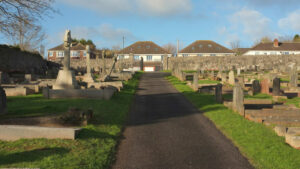 The first interment took place in the Nonconformist section in 1852. This was because the Bishop of Exeter, Dr Henry Philpotts, only allowed the consecration of the cemetery after the Anglican section was physically separated from any adjoining burial ground by a wall. The first Anglican internment then took place in June 1854.
The first interment took place in the Nonconformist section in 1852. This was because the Bishop of Exeter, Dr Henry Philpotts, only allowed the consecration of the cemetery after the Anglican section was physically separated from any adjoining burial ground by a wall. The first Anglican internment then took place in June 1854.
At the same time, a chapel was consecrated for the use of Anglicans; a chapel for the Nonconformists wasn’t built until 1862. Such double chapels (one for Anglicans, one for Nonconformists) were common in Victorian cemeteries. As in life, Torquay’s dead would be separated by religion.
The opening of Pere Lachaise Cemetery in Paris in 1815 had provided inspiration for our local cemetery designers. And so, our necropolis was landscaped, with sweeping roads wide enough for carriages, and smaller paths for strolling. Careful planting of trees and architectural features were designed to impress and give the effect of a park, with our dual chapels taking the place of a country house.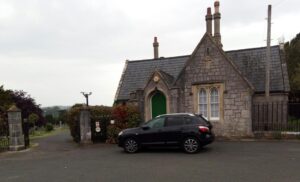
The cemetery’s cast-iron carriage gates and Tudor Gothic style lodge
The cemetery’s entrance was comprised of cast-iron carriage gates set in high walls near a stone lodge in Tudor Gothic style. Such entrances were elaborately fashioned, marking the fact that visitors were entering an alternative community of the dead. Here you could leave behind the busy mercantile town outside to enter a spiritual realm of contemplation. From the gates a drive follows a curving course either to reach the Anglican or the Nonconformist chapel.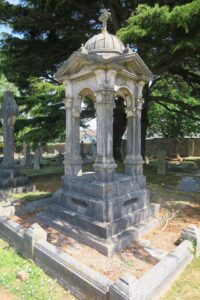 Yet there was no equality, even in death. For Torquay’s middle and upper classes such a commercial ‘garden cemetery’ facilitated the spending of great amounts on building monuments and tombs for the departed. It was expected that an aspiring family would spend as much as it could afford on a stone or marble monument appropriate to the deceased’s (and the family’s) social status.
Yet there was no equality, even in death. For Torquay’s middle and upper classes such a commercial ‘garden cemetery’ facilitated the spending of great amounts on building monuments and tombs for the departed. It was expected that an aspiring family would spend as much as it could afford on a stone or marble monument appropriate to the deceased’s (and the family’s) social status.
This was a new opportunity for conspicuous display which particularly appealed to our newly emerging middle class, keen to distance itself from the working class and to present to the public its advance. Graves were seen as a public extension to the household’s property, and cemeteries provided a secure and well-maintained place for families to establish permanent monuments to themselves. It was a kind of immortality and, if necessary, worth incurring debt.
From the 1850s onwards our cemetery was somewhere to visit, to reflect and contemplate. Its winding roads and picturesque vistas was an important space for recreation; a large piece of ground filled with sculptures and horticultural art.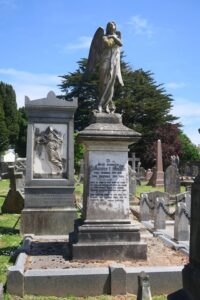 Victorian graves tended to be much more elaborate than their modern counterparts. Monuments were usually symbolic. Often religious (angels, the letters IHS, a monogram for ‘Jesus Saviour of Man’ in Greek), alongside representations of a profession (horseshoes for a coach driver, palette for a painter). Prominent are symbols of death: urns (classical symbol of Roman cremation); wreaths (of eternal life); broken columns (of life cut short); upside-down torches (the extinguishing of life); grieving women; obelisks (the Egyptian image of eternal life).
Victorian graves tended to be much more elaborate than their modern counterparts. Monuments were usually symbolic. Often religious (angels, the letters IHS, a monogram for ‘Jesus Saviour of Man’ in Greek), alongside representations of a profession (horseshoes for a coach driver, palette for a painter). Prominent are symbols of death: urns (classical symbol of Roman cremation); wreaths (of eternal life); broken columns (of life cut short); upside-down torches (the extinguishing of life); grieving women; obelisks (the Egyptian image of eternal life).
Such symbols could also subtly inform the visitor of the family’s views on religion. Torquay’s dominant Anglicans, for instance, could distance themselves from other local Protestant traditions such as the Methodists or the Quakers, and particularly from the town’s growing Catholic community; some Protestants even seeing a cross as too much of a symbol associated with Rome.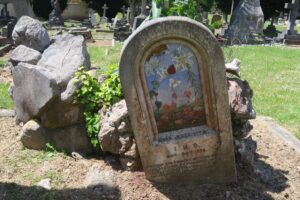 These statements can be seen in the numerous memorials and burials of notable individuals and families. One striking example is the monumental white marble sarcophagus commemorating Isaac Merritt Singer of Oldway Mansion. This Renaissance-style sarcophagus is ornamented with plants of symbolic significance such as maize, indicating Singer’s American origins. Also found here is the grave of George Marsden Waterhouse, Prime Minister of New Zealand, showing the town’s status as a place of retirement for many famous Victorians.
These statements can be seen in the numerous memorials and burials of notable individuals and families. One striking example is the monumental white marble sarcophagus commemorating Isaac Merritt Singer of Oldway Mansion. This Renaissance-style sarcophagus is ornamented with plants of symbolic significance such as maize, indicating Singer’s American origins. Also found here is the grave of George Marsden Waterhouse, Prime Minister of New Zealand, showing the town’s status as a place of retirement for many famous Victorians.
Yet, even in death, nothing would stay the same.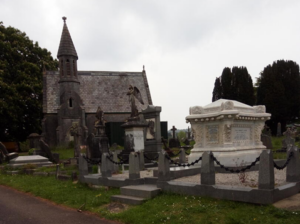
The Renaissance-style sarcophagus of Oldway’s Isaac Merritt Singer
Towards the end of the nineteenth century people began to object to the crippling cost of funerals, monuments, and the rituals of ostentatious mourning. Technology was making the world more open, both psychologically and physically. There also came a reaction against Queen Victoria’s obsessive grieving for her husband and her withdrawal from public appearances. A new century and Edward VII’s succession in 1901 saw attitudes changing.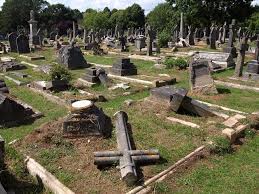 What made most difference, however, was the senseless waste of World War I which challenged the certainties of Empire and Faith. So many were lost or buried in France that Victorian monuments suddenly seemed inappropriate. Almost immediately, lavish displays for the dead disappeared. We subsequently came to see the world in new ways.
What made most difference, however, was the senseless waste of World War I which challenged the certainties of Empire and Faith. So many were lost or buried in France that Victorian monuments suddenly seemed inappropriate. Almost immediately, lavish displays for the dead disappeared. We subsequently came to see the world in new ways.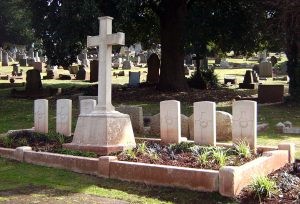
The modest burials of servicemen from New Zealand
As attitudes to death evolved, cemeteries began to be laid out differently. Headstones became more discreet and monuments less extravagant. Then we can see the simple memorials to the twentieth century victims of conflict in the 136 burials of the First World War and the 97 from the Second World War. We can also appreciate the contribution of the Empire in the group commemorating servicemen from New Zealand. Here was a new equality in death that replaced petty Victorian rivalries.
The greatest change in the post-Victoria era was, however, the gradual acceptance of cremation, first proposed by a few radical thinkers in the late nineteenth century. Cremation was not illegal in England, the first working crematorium was built in Woking in 1879, but it was not widely practised. However, in 1902 Parliament passed the Cremation Act which formalised the practice.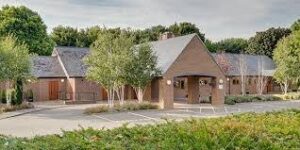
Today’s Crematorium
In 1929 another area was acquired from the Cary Estate to the north of Hele Road. Here they built a crematorium. By 1968 more than half of all the dead in Britain were cremated; today, it’s around 80 per cent.
And so, since 1852, Torquay’s cemetery has reflected the social and economic development of our town. Yet, although we all know where our town’s necropolis is, few now visit. Perhaps we should.
Torquay: A Social History by local author Kevin Dixon is available for £10 from Artizan Gallery, Fleet Street, Torquay, or:
https://www.art-hub.co.uk/product-page/torquay-a-social-history-by-kevin-dixon



